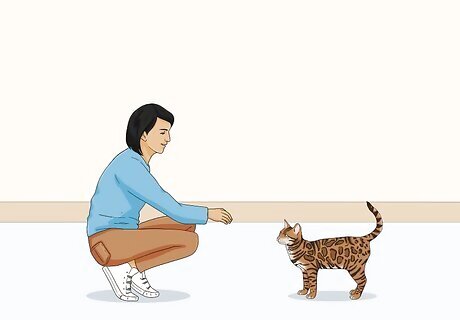
views
Fostering Good Social Skills in Your Cat

Ask guests not to approach your cat. When you have guests over, ask them to let your cat approach them, instead of the other way around. Cats are generally curious by nature, so letting them explore new guests without becoming startled can help to socialize them. Cats may be less likely to approach children, guests who are very tall, or people they've never encountered before. Be especially patient with your cat when guests of this kind come by.

Eye contact can be seen as a threat, so ask your guest to simply ignore the cat. Instead, the person can take a seat and drop a few treats from their hand to help the cat build a positive association.

Coax him out of hiding. If you have guests over, but your cat is nowhere to be seen, try shaking his food bag, or (if he eats canned food) running the can opener to coax him from his hiding spot. You may also try jingling a toy that he likes. If your guests are patient and calm, you may consider bringing your cat out. However, make sure he has an escape route if he becomes overwhelmed.

Ask guests to squat or sit. Cats tend to be afraid of particularly large and/or tall people. Ask your guests to sit down or squat to make your cat feel more comfortable around them.

Prepare for strangers. Having planned guests over is one thing; however, sometimes unexpected strangers (like a pizza delivery person, mail carrier, or missionary) may arrive at your door. Strangers are the not right people to use for breaking your cat's xenophobia. Allow your cat to run and hide if he wants to.

Make sure your cat has places to hide. It may sound counterintuitive, but if your cat has a safe bolt hole (an empty cardboard box, for instance) then he may be more willing to be brave. Make sure he has access to his hiding places when guests are over. You can also provide vertical spaces for the cat to escape to if he feels threatened, such as tall cat trees. He can also watch and assess a situation safely, before deciding it's OK and he wants to join in. Knowing when to hide and protect himself and when to come out and play is an excellent social skill for your cat to develop.

Encourage him to play. When guests are over, you (or someone else the cat trusts) can sit with him nearby. You can pet him, offer him treats, and encourage him to play. If you can get him into a positive and playful mood, he’ll be more likely to interact with new people.

Don't cut off his escape route. You may be frustrated by your cat's fear or really want him to stay and play, but trapping him can cause him to panic and won't do much to cure his xenophobia. Make sure guests leave a clear route between the cat and the door or his hiding place so he can escape if necessary.

Try synthetic cat hormones. When a cat feels safe and comfortable he will rub his face against objects, which leaves a facial pheromone. Products like Feliway mimic these pheromones, which may help reassure your cat that he is in a safe environment.

Consider anti-anxiety medication. If your cat is experiencing ongoing anxiety, speak to your vet about including anti-anxiety medication in your method. This may help your cat stay calm enough to gain a critical level of socialization. Your vet might recommend using zylkene, which can help pets manage stress. Some people believe that certain flower extracts, such as Bach Flower Remedies' "Rescue Remedy", can help their cats relax. Give the proper dose to the cat before company arrives. Always consult a veterinarian before administering medication to you cat.
Using a “Starting Distance” Method

Provide a safe area. If you’d prefer a more methodical approach, you can follow a “starting distance” methodology with your cat. Begin by creating a safe space. Before any guests arrive, provide your cat with a safe area to go. This will be an area where the cat can completely avoid guests. Provide water, food, and a litter box. Place your cat in the safe space (but don’t lock him in) and let him remain there while guests arrive. This will help your cat to stop associating the presence of guests in the home with anxiety.

Find your cat's "starting distance." When you have a particularly patient guest, ask them to help you find your cat’s starting distance. When you cat emerges from the safe area, have your guest come as close as they can to your cat before the cat displays any signs of anxiety or aggression. This is your cat’s approximate starting distance.

Begin with a motionless guest. The next time a guest comes over, remove your cat from the safe area, and place him at his approximate starting distance from the guest. Ask your guest to remain motionless (standing or sitting), and allow the cat to investigate them. If the cat remains calm, reward his behavior with treats, play, or petting and attention for a few minutes, then put him back in the safe area. You can repeat this exercise a few times while your guest is visiting. If the cat seems uncomfortable, move him further away until he is calm, and reward him as just outlined.

Decrease the distance by a few inches. Keep doing these sessions, each time watching your cat carefully. Have the guest move slowly and with gentle motions. Your guest doesn't need to say anything, but they may choose to speak in soothing tones. Eventually, the cat will be calm enough to remain within arm's reach of the guest. Anti-anxiety medication can help with this process also. If your cat becomes anxious, simply increase the distance until he is calm.

Incorporate movement. Once your cat is fairly comfortable approaching a guest that is still, see what happens if your guest moves around. Ask your guest to pace back and forth or make any movement that you want your cat to get accustomed to. (You may find that the starting distance is longer as some cats are more timid about movement.) Repeat the exercises with your guest moving so that your cat becomes desensitized.
Preventing Xenophobia in Kittens

Know your kitten’s age. A kitten of any age can benefit from exposure to new people; however, kittens between two and seven weeks old have been shown to benefit immensely from socialization. If you have purchased the kitten from a breeder or pet store, you may not have the kitten until he is six or seven weeks old, so it is important to bring him around people right away.

Provide a safe environment. When you bring home a new kitten, give him a little time to become comfortable. (This length will vary from kitten to kitten, but a couple of days is a good rule of thumb). Once he seems comfortable around you and in your home (he is exploring on his own, snuggles with you, and is eating), begin to invite guests over.

Expose your kitten to diverse people. Kittens will grow accustomed to people if they are exposed to many different types of people when they are young. Invite over friends of different sizes, shapes, and ages. Invite people of various races and genders. Additionally, it is good for him to encounter people who look “unique” for one reason or another (such as people who use wheelchairs, people with beards, or people who wear hats and/or glasses). Make sure that the people around your cat are kind and gentle. Avoid very loud noises. Be careful with young children, who may not understand how to handle a kitten.

Reward him with praise. Anytime your kitten actively approaches a new person and interacts with them, reward the kitten with affection and praise. It is important to teach your kitten that this is a desired behavior. You may even want to offer him a treat.



















Comments
0 comment